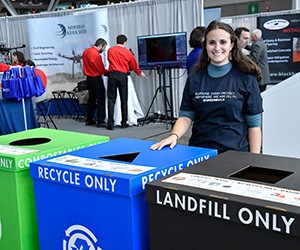The world’s largest green building conference and expo is blazing another trail.
Greenbuild, which has spotlighted the latest and greatest in sustainable buildings since 2002, asks conference attendees to take a pledge promising to take at least three sustainable actions during the event.
The 2018 show in Chicago marks the second year that Greenbuild attendees have been asked to take a pledge.
“When our attendees and exhibitors are at home, they have great habits and routines for a more sustainable lifestyle," explained Megan Magaña, senior marketing manager for Informa Exhibitions, which produces the event with the U.S. Green Building Council (USGBC). "They’re recycling, they’re using reusable water bottles and making responsible food choices. That shouldn’t change because they’re on-site at the event."
“Our hope is that this gentle reminder and interactive opportunity on-site shows attendees that Greenbuild acknowledges their efforts at home and supports the effort it takes to make sustainable choices while traveling,” she added.
How to Structure Pledge Options
The pledge was inspired by a similar initiative that the American Chemical Society implemented at its annual events, Magaña said. The five pledge options at Greenbuild 2017 could apply equally to any city, but the nine best practices for 2019 are full of local color, such as using Divvy bike rentals or CTA trains and buses to get around the city rather than a general request to reduce carbon emissions.
[Earth Day Infographic: Avoid Using Single-Use Plastic at Events]
The Chicago-specific items were suggested by the Illinois Green Alliance, Greenbuild’s local host partner organization for this year’s event. Registrants this year chose from the following options:
- Use low carbon transportation like bicycles (Divvy) or trains and buses (CTA) and if I must use Uber/Lyft/Taxi, I will carpool.
- Consider staying at a Certified Green Hotel in Chicago.
- Use the linen and towel reuse program at my hotel and turn off lights when I leave my hotel room.
- Bring my reusable water bottle/coffee mug and reusable bag with me (and avoid the City of Chicago plastic bag tax).
- Responsibly dispose of waste materials by recycling or composting at the convention center, at my hotels, and at the outdoor Bigbelly recycling stations around the city.
- Download and use the mobile app instead of the printed Expo Guide for Greenbuild.
- Choose sustainable, local or organic food whenever possible when dining out during the event, and in true Chicago style, I will not put ketchup on my hot dog and I will only eat pizza in square form.
- When I drink beer, I will choose Illinois draft beer over cans (preferable) or bottles (less preferable).
- Learn about the importance of water in Chicago by visiting the Chicago Water Tower, Riverwalk or a lakefront beach.
With just two weeks to go until the show, bringing a reusable water bottle has emerged as the most popular choice, with responsibly disposing of waste and using low-carbon transportation in a tie for second.
Water stations throughout host venue McCormick Place will provide ample opportunities to refill reusable bottles, Magaña noted, and Greenbuild organizers are excited to beat last year’s record 90.5 percent waste diversion rate.
[Related Content: Hawaii Convention Center Launches Conservation Program]
Sustainability pledges during registration are “definitely something that’s catching on,” said Kate Hurst, SVP of conferences and events for USGBC. “It comes down to what your goals are. Greenbuild has sustainability goals across all aspects of our event, but it depends on how important it is for an event to engage attendees. It’s easy to add a dialogue or dropdown menu into your registration process and get people to start thinking about it. Make sure you’re also hitting people with these concepts on-site by reminding them of the pledge options.”
Make it Easy to Engage
The pledge questions aren’t required to finish the registration process, but one new registration detail this year is required—deciding whether to reserve a printed copy of the conference program. This minimizes paper waste by ensuring that Greenbuild only prints the quantity of programs it needs.
“The guide is made with 100% post-consumer waste recycled paper and vegetable-based inks already, but printing fewer means less resources to create and transport them,” Magaña said.
Hurst recommended working with meeting venues to make it as easy as possible for attendees to make good decisions that align with your event’s goals.
In Greenbuild’s case, each annual expo requires reviewing the event sustainability plan to customize it to local needs and resources and improve on best practices based on previous experience. The waste diversion component alone is refined over the course of most of a year and includes “all the different types of waste that will touch the Greenbuild expo floor and our breakout sessions,” Hurst explained.
“Every year we’ve built on the sustainability plan and added additional components. Start small and build,” Hurst said. “You can’t do everything the first year out, and it takes a lot of time and planning. Every little bit helps.”
[Read This Next: 2018 Sustainable Events Trends -- Zero Waste, Service Projects and Partner Collaboration]







